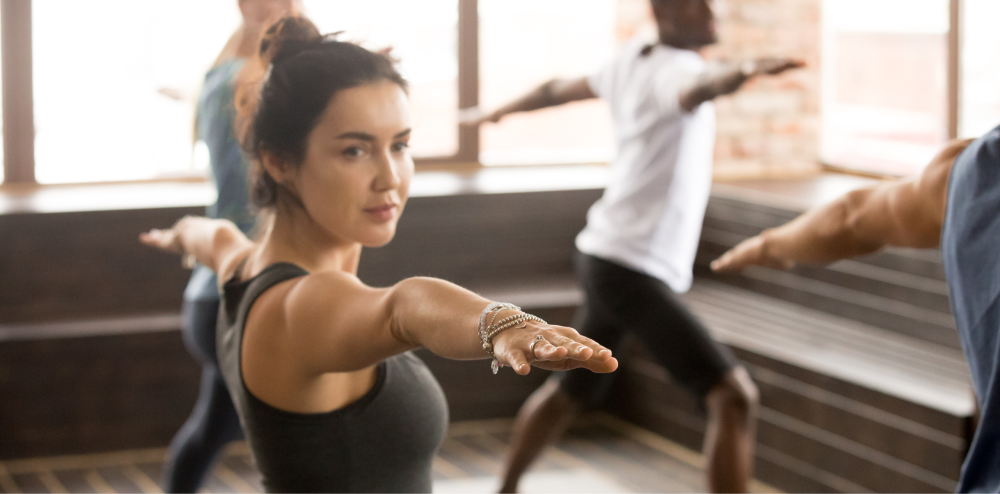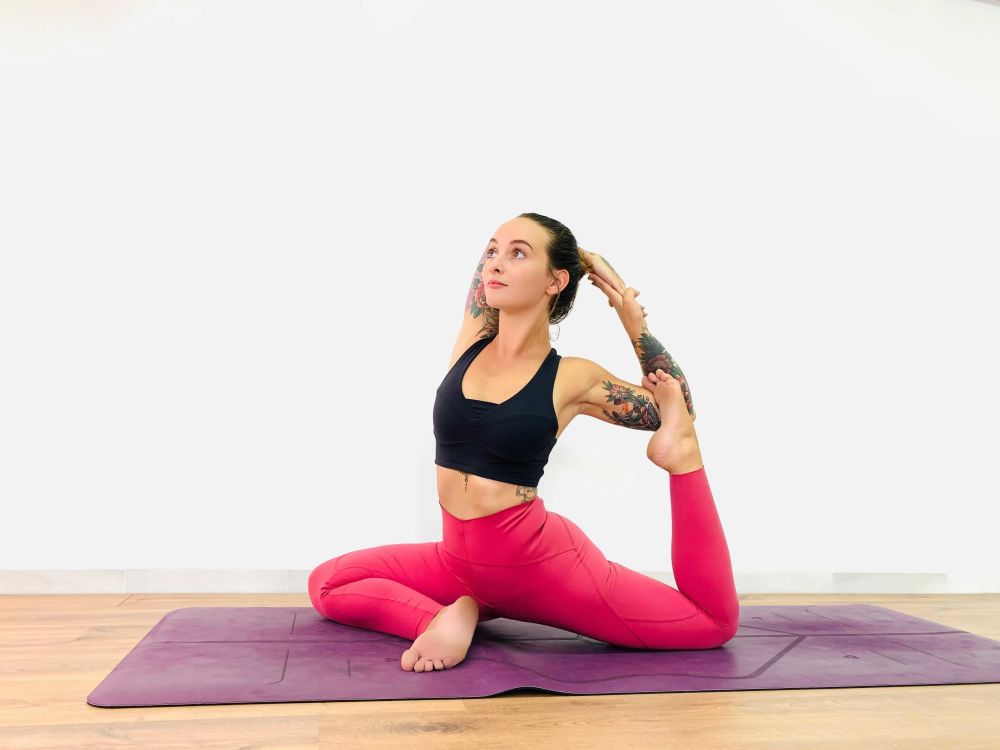How to become a yoga instructor

Yoga is one of the most popular hobbies in the UK, allowing those who attend to improve their wellbeing, relieve stress and embark on some self reflection and awareness. As a yoga teacher, it’s up to you to enable this practice, using your passion to help your students achieve their desired outcome.
If you want to turn your love of yoga into a career, this article will show you the skills and qualifications you’ll need, the salary you could earn and some steps you can take to become a yoga instructor with insights from Superscript’s resident yoga teacher, Zena.
Assess your skills
When you think about the great yoga teachers who have taught you, what do they all have in common? We’re going to bet there are some similarities. Being a yoga instructor not only requires the skills of a teacher but because as yoga follows specific flows and practices, it's often delivered in a certain way, which requires a certain skill set, too.
To become a yoga teacher, it helps to have at least some if not all of the below skills:
- Observation and attention to detail
- Multitasking
- Confident verbal communication
- Empathy
- Expert knowledge of the practice
- Flexibility
- Calm and caring manner
- The ability to handle all abilities and experience levels
- A business mindset, if you’re planning on running a yoga business yourself
- To think on the spot
If your skill set matches the above, you should be well-suited to become a yoga instructor.
Decide on your training and get qualified
The next and probably most important step to becoming a yoga teacher is the training.
Typically, most people complete a level 3 diploma in teaching yoga. This is the basic level that’s recommended by the UK government to acquire.
Within the course you’ll learn about the history and philosophy of yoga; breathing, meditation, asana and pranayama techniques; planning lessons as well as health and safety through anatomy and physiology.
After you’ve achieved a basic qualification, many teachers go on to build on their training by attending more courses that focus on various areas and styles of yoga.
You'll find 200-hour, 300-hour and 500-hour courses ranging from as little as 3 weeks to as long as 2 years. So, the course you choose is really dependent on the type of yoga you want to teach and how much time you have to dedicate to your training. With roots in India, many people also travel to the country in areas such as Rishikesh and Goa to learn from native yoga practitioners.
To put this into perspective, Zena’s training involved “becoming a Meditation Practitioner & completing 200hr Hatha Yoga teacher courses with the British School of Yoga to start with.” She then “enrolled in another 200hr Hatha Yoga Teacher Training with an Ashram in Rishikesh, India.” And has “since completed an additional 50hr Yin Yoga training, Teaching Methodology training, and another training course in Barcelona to be able to teach Rocket Yoga!”
With these qualifications, she teaches group classes across all abilities.
Do you need a qualification to teach yoga?
There is no statutory regulation for yoga in the UK and it is largely self-regulated.
There is only one national governing body in the UK for yoga and that’s the British Wheel of Yoga. They offer OfQual-regulated yoga teacher qualifications, which are benchmarked against national education standards.
Other governing bodies include the Yoga Alliance UK and Iyengar yoga UK. However, there are tons of colleges, academies and associations that offer the level 3 diploma in teaching yoga.

Pick your specialisms
Yoga is an ancient practice that has evolved over centuries. This has caused a few different styles of yoga to develop with some even forming as late as the 1980s and will no doubt continue to shift.
As there are so many styles – some more popular or well-known than others – you should aim to focus on learning how to teach one or two to begin with. From there, you can add more to your teaching belt and slowly become a master of each one.
Each style is unique, focusing on movement and breathing in its own way. Some of the different forms of practice include:
- Hatha yoga – this is an umbrella term for the physical forms of yoga. This encompasses styles such as ashtanga and Iyengar, while branches such as kriya, raja, and karma are separate from physical-based yoga. As it’s usually taken at a slower pace, Hatha is great for beginners.
- Ashtanga translates as “eight limbs”, which refers to the eight limbs of yoga written in the Yoga Sutras of Patanjali. Each limb represents various stages of yoga practice, from our attitudes to ourselves and our environment to breathing and physical postures. This encourages you to extend the practice beyond yoga sessions and into your everyday life. The style focuses on a sequence of poses paired with synchronised breathing.
- Vinyasa was adapted from ashtanga in the 1980s and is considered the most athletic style. It uses similar poses to ashtanga but the order can be changed.
- Rocket yoga is another style that’s based on ashtanga. It blends the poses in the ashtanga sequence together to create a more fluid but challenging session. It encourages playfulness and curiosity, modifying poses to suit your body’s limits.
- Iyengar focuses on alignment, precise movements and controlling the breath. Poses are typically held for a long time while adjusting slowly, going deeper into each one.
- Kundalini is both spiritual and physical, encouraging students to release kundalini energy that could be trapped in your lower spine. Classes can involve breathing exercises, chanting, mantra and intense poses that work the core.
- Yin yoga is considered a slower pace practice focused on helping students find their inner peace. It involves seated positions that are held for a longer period of time. Classes are relaxed and not too demanding, which is great for beginners.
There are many other forms of yoga, such as anusara, jivamukti and hot yoga, so it’s worth reading up about them and deciding which ones you’d like to teach.
Of course, if you’re already passionate about yoga, you should have an understanding of the forms that you prefer, but you never know – you might discover a new style that speaks to you.
Choose your teaching style
As you’ll no doubt know, every teacher is different. Setting your teaching style will help you determine the desired outcomes of your sessions and even help you choreograph.
Ask yourself: what do I want my students to achieve in my lessons? This could be a new technique, complete relaxation or connecting to themselves. When thinking about this, it’s wise to consider what level your students might be at.
Zena says, “working with all students' abilities, my classes have a main emphasis on breathing and finding the ability to leave the outside world as it is whilst practising; using movement and breath to gain a deeper connection to your true self.”

Design a course and lesson plans
This is where your creativity kicks in. Using your deep knowledge of poses and flows, you can choreograph your own sequences and movements, deciding on the length of time to hold the poses, too.
Some teachers like to know exactly what they’re going to teach in each session, while others are more spontaneous, letting their bodies decide for them or asking what the class wants to include and go from there.
Either way, it always helps to have some back-up sequences in your mind in case you go blank.
Decide where you want to conduct classes
When it comes to offering your yoga sessions in various locations, you have a few options:
- In your own home, either in-person or online
- In a studio
- One-to-one, either in a rented studio or in a client’s own home
- At gyms and leisure centres
- Abroad – this could be at resorts, hotels or cruise ships
- Retreats, either partaking in one or running small retreats yourself
Each one has their merits, and some may be more suited to your schedule and lifestyle than others.
Buy business insurance
Even with all the training in the world, an accident could happen in one of your classes, causing a student to injure themselves or damage their property. If this happens and they try to sue you, it could result in hefty legal and compensation fees, not to mention tarnish the reputation you’ve built for yourself.
Business insurance for yoga instructors can include public liability, employers’ liability – which is a legal requirement if you employ people – personal accident cover and cyber insurance.
Keep in mind that if you’re working in a gym, a studio or even for a private client, they may require you to have yoga business insurance. And from as little as £6.76 a month, it’s worth thinking about.
How much do you make as a yoga teacher?
According to Glassdoor, the average yoga teacher salary is just under £26k per annum in the UK. Most yoga teachers will charge by the hour, with the average being between £20-£50 in the UK.
If you offer private classes or one-to-one sessions, you can decide how much to charge. However, if you work for a studio or gym, they will likely pay you a set salary or will take a cut of your class-goer fees based on how many attend.
How much you charge as a yoga teacher will largely depend on how much experience you have, where in the country you are based and the level at which you teach.
How long does it take to become a yoga teacher?
This depends on whether you take a crash course or take your training slow.
Each association also has their own minimum contact hours that you need to complete in order to get qualified. While this varies, it’s usually around 2 years' of practising with a qualified yoga teacher.
We hope these tips help you become the best yoga teacher you can be. Namaste and happy teaching!



